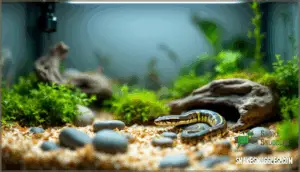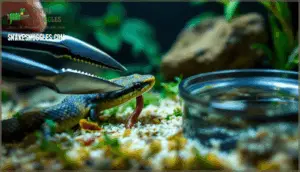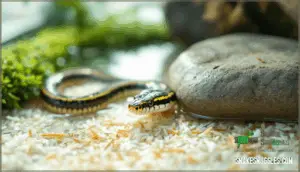This site is supported by our readers. We may earn a commission, at no cost to you, if you purchase through links.

These small colubrids don’t require specialized lighting or complex heat systems, and they accept a wider variety of prey than most captive reptiles. If you source a healthy specimen, provide appropriate temperatures between 75-85°F, and offer thiaminase-free food options, your hatchling will shed cleanly, grow steadily, and display the calm temperament these snakes are known for.
Table Of Contents
- Key Takeaways
- Choosing The Right Baby Garter Snake
- Setting Up a Safe Enclosure
- Feeding Your Baby Garter Snake
- Maintaining Cleanliness and Health
- Handling and Monitoring Progress
- Frequently Asked Questions (FAQs)
- How to take care of a garter snake for beginners?
- How to raise a baby garter snake?
- What do baby garter snakes need?
- How long does it take for a baby garter snake to grow?
- How often should I feed my baby garter snake?
- What temperature range is ideal for garter snakes?
- Can baby garter snakes be housed together safely?
- How do I know if my garter snake is shedding?
- When should I start handling my baby garter snake?
- Can garter snakes be housed with other species?
- Conclusion
Key Takeaways
- Baby garter snakes thrive with three essentials: selecting a healthy hatchling from a reputable source, setting up a 10-gallon tank with proper temperature gradients (75-85°F), and establishing a feeding routine with safe prey like earthworms or fish to avoid thiaminase toxicity.
- Garter snakes don’t require specialized lighting or complex heating systems, making them forgiving pets for beginners who meet their basic needs of secure housing, consistent hydration, and regular spot cleaning to prevent ammonia buildup.
- Feed hatchlings every 3-5 days with thiaminase-free options like Canadian nightcrawlers or feeder guppies, transitioning to pinky mice around 12-14 inches in length, while monitoring shedding cycles every 14-21 days as indicators of healthy growth and hydration.
- Handle hatchlings gently for 5-10 minute sessions after a 7-10 day acclimation period, watch for stress signals like cloudy eyes or hiding, and seek veterinary care immediately if you notice respiratory issues, retained shed, or behavioral changes indicating illness.
Choosing The Right Baby Garter Snake
Before you bring a baby garter snake home, it helps to know exactly what you’re looking for. Choosing the right hatchling means thinking through your options and planning ahead.
Here’s what you’ll want to think about as you get ready to welcome your new companion.
Researching Garter Snake Species
How do you pick the right garter snake species for your home? Start by studying a Garter Snake Species Overview, paying close attention to regional variations and habitat preferences. Noticing physical traits such as stripe color or body size is key. Stay alert for hybridization events—they can blur species boundaries and complicate identification when comparing garter snake characteristics across subspecies. The endangered snakes face threats from habitat loss.
- Investigate common local species and their adaptations.
- Compare physical traits: stripes, color, and size.
- Learn about natural habitats—grasslands, wetlands, or forest edges.
- Consider the potential for hybrids in overlapping ranges.
Selecting a Healthy Hatchling
Once you’ve learned what sets the different garter snake species apart, it’s time to spot the telltale signs of good health in a hatchling before you bring one home. Look for baby garter snakes with active tongues, clear eyes, and plump bodies—strong indicators of well-used yolk reserves.
Source ethically, weigh breeder versus pet store options, and ask about genetic considerations for species suitability.
Preparing for Your Snake’s Arrival
Now that you’ve picked out a healthy hatchling, let’s make sure everything’s ready for your new little companion to settle in smoothly. Here’s your Pre-Arrival Checklist:
- Plan your budget—don’t forget hidden costs.
- Gather Essential Supplies for baby garter snake care.
- Set up and snake-proof the tank habitat.
- Review Garter snake housing and feeding needs.
- Prepare Quarantine Procedures.
Setting Up a Safe Enclosure
When your new garter snake arrives, the right setup makes all the difference. Before your snake can feel at home, you’ll need to get a few key things in place.
Here’s what to have ready for a safe, comfortable start.
Selecting The Correct Tank Size
Think of a baby garter snake’s new home a bit like Goldilocks’ search—not too cramped, not too roomy, but just right for a sense of security and healthy growth. Aim for a ten-gallon tank for one, factoring Tank Size Ratios: too large, and your hatchling may stress.
When Housing baby garter snakes together, upsize and consider Long-Term Needs and Enrichment.
Choosing Safe Substrate and Decor
From the bottom of the tank up, what you put inside your baby garter snake’s home shapes how safe and comfortable they’ll feel. Safe substrates like paper towels or aspen shavings top the list for Cleaning Ease, while Decor Enrichment—think artificial plants or bark—offers both hiding spots and a touch of Naturalistic Setup. Choose decor that aids Humidity Control and fits your snake habitat vision.
Creating Proper Temperature and Humidity Gradients
In every corner of your garter snake’s enclosure, getting the temperature and humidity just right helps your hatchling explore, digest, and feel at home. Place the heat lamp to create a gentle temperature gradient, then add a humidity box filled with moist sphagnum.
Gradient monitoring tools make Seasonal Adjustments easy, accounting for natural Species Variations. This balance prevents dessication in delicate reptile babies.
Providing Secure Lids and Hiding Spots
When you set up your snake’s new home, nothing brings peace of mind like knowing the lid clicks tight and there’s a cozy hiding place waiting underneath. Choose heavy-duty lid materials for Escape Prevention—baby garter snakes are clever.
Scatter a variety of naturalistic hides or a secure hideout box inside the enclosure. Hiding variety calms neonate snakes, promoting safe, thriving growth.
Feeding Your Baby Garter Snake
Feeding your baby garter snake can feel a little intimidating at first. With the right approach, you’ll quickly learn what keeps your hatchling healthy and satisfied.
Here’s what you need to know before you start picking food options.
Understanding Dietary Needs of Hatchlings
Ever wonder how something so small can have such a big appetite for variety right from the start? Neonate feeding presents unique challenges—baby garter snakes may refuse unfamiliar food items or struggle with dietary conversion.
Understanding worm toxicity, the risks of live prey, and how early pinky introduction affects baby snake feeding problems sets the foundation for healthy, thriving neonates.
Offering Safe Food Options (Worms, Fish, Pinkies)
You’ll offer baby garter snakes three primary safe food options: Canadian nightcrawlers, thiaminase-free fish like feeder guppies or platies, and pinky mice. Safe worm types exclude toxic red wigglers, which secrete harmful substances.
Pinky introduction becomes practical once hatchlings reach 12–14 inches, with feeding frequency shifting from every other day for worms and fish to every 3–5 days for pinkies.
Garter snakes also need adequate UVB lighting to thrive in their enclosures. Nutritional balancing across these food sources prevents deficiencies and promotes healthy growth.
Avoiding Toxic Prey and Ensuring Hydration
Red wigglers aren’t the only danger lurking in your feeding routine—dehydration kills baby garter snakes just as quickly as toxic prey. You’ll maintain fresh water daily in shallow dishes, preventing drowning while guaranteeing hydration for neonate garter snakes.
Fish-based diets pose thiaminase risks, particularly goldfish and carp, which destroy vitamin B1 and cause neurological damage. Water quality matters, too—chlorinated tap water requires dechlorination before offering it to hatchlings.
Proper hydration prevents shedding issues that compromise skin integrity and overall health.
Troubleshooting Feeding Refusals
Even with perfect hydration and safe prey, your hatchling might refuse to eat, and understanding why separates experienced keepers from those who panic at the first missed meal. Neonate garter snakes experience stress-related appetite loss during environmental transitions, requiring patience rather than forced intervention.
Understanding why your hatchling refuses food separates experienced keepers from those who panic—stress-related appetite loss during transitions requires patience, not forced intervention
You’ll address feeding refusal through scenting food with fish slime, offering smaller prey items, or adjusting temperature gradients before considering assist feeding—a technique reserved for persistent food aversion threatening the snake’s survival.
Maintaining Cleanliness and Health
A clean enclosure isn’t just about avoiding odors—it’s the foundation of your baby garter snake’s immune defense and long-term vitality.
Regular maintenance prevents bacterial blooms, identifies health issues early, and fosters proper shedding cycles.
Here’s what you need to monitor and maintain throughout your hatchling’s critical growth phase.
Cleaning and Disinfecting The Enclosure
Baby garter snakes defecate frequently, sometimes within hours of feeding, so you’ll need to clean their enclosure at least once a week to prevent ammonia buildup and bacterial growth. Remove waste immediately with spot cleaning, and replace soiled substrate as needed.
Disinfect water bowls daily with mild detergent, then rinse thoroughly. For full maintenance, use a diluted bleach solution on surfaces, making certain to complete rinsing before reintroducing your snake—this helps with odor control and prevents disease.
Monitoring for Signs of Illness or Stress
Beyond keeping surfaces clean, you need to watch your snake for Behavioral Changes and Skin Abnormalities that signal trouble. Over 70% of sick garter snakes show lethargy before other symptoms appear, and Respiratory Distress—like open-mouth breathing—affects up to 25% of illness cases. Pay attention to Feeding Habits, since refusal often points to mouth infections or stress. Watch for:
- Excessive hiding or burying, present in 80% of illness reports
- Red scaling, swelling, or lesions on skin or belly
- Audible wheezing or mucus around the mouth
- Visible bumps suggesting mites, leading to anemia
- Regurgitation or diarrhea indicating parasites
Regular health assessment and Fecal Analysis help with identifying reptile illness early, so you’ll know when veterinary advice is necessary to protect your snake’s reptile health.
Ensuring Proper Shedding and Growth
A healthy shed cycle is a key indicator of whether your baby garter snake is absorbing nutrients and maintaining proper hydration. Tracking this pattern provides valuable insights into the snake’s overall growth. Baby garter snakes typically shed every 14–21 days during their first six months, with environmental factors like humidity significantly affecting shedding frequency. Low hydration levels can lead to desiccation and incomplete sheds, while dietary impact directly influences growth rate.
| Factor | Healthy Range |
|---|---|
| Shedding Frequency | Every 14–21 days |
| Humidity Level | 50–60% with moist hide |
| Growth Rate | 1–2 inches per month |
| Dietary Impact | Protein-rich meals 2–3× weekly |
| Hydration Signs | Clear eyes, supple skin |
To monitor your garter snake’s health, observe each shedding event closely. Cloudy eyes and dull skin are signs that a shed is approaching.
When to Seek Veterinary Care
Knowing when your baby garter snake needs professional medical attention can mean the difference between a quick recovery and a serious health crisis. Schedule annual check-ups with a reptile vet to catch issues early. Contact your veterinarian immediately if you observe:
- Respiratory infections – wheezing, mucus around nostrils, or mouth breathing
- Dysecdysis issues – retained shed, especially around eyes or tail tip
- Parasite detection signs – weight loss, regurgitation, or abnormal feces
Common illnesses in garter snakes require prompt injury assessment and reptile veterinary advice.
Handling and Monitoring Progress
Interacting with your baby garter snake properly and keeping track of its development are key parts of successful care. Gentle, consistent interaction helps build trust while regular observations reveal whether your snake is growing at a healthy rate.
The following points will guide you through secure interaction practices, growth monitoring, and adjustments you’ll need to make as your hatchling matures.
Safe Handling Techniques for Hatchlings
When you first reach into your hatchling’s enclosure, you might be surprised by how delicate and quick these tiny snakes can be. Interacting with them safely requires a gentle touch, patience, and an understanding of their defensive instincts. Support your baby garter snake’s body with both hands, allowing it to move freely without squeezing. Wash your hands before and after each session to prevent disease transmission.
Raising baby garter snakes means respecting their size—a hatchling may strike when frightened, but won’t cause harm if you stay calm and move slowly.
| Handling Aspect | Technique | Why It Matters |
|---|---|---|
| Gentle Grasping | Support mid-body with open palms | Prevents injury to fragile neonate bones |
| Reducing Stress | Limit sessions to 5-10 minutes | Minimizes defensive striking acting |
| Avoiding Bites | Never grab from above | Mimics predator approach, triggers fear |
| Hygiene Practices | Wash hands thoroughly before/after | Blocks bacterial and parasitic transfer |
| Supervised Handling | Adult must observe children closely | Assures safe interactions for both parties |
Socializing Your Baby Garter Snake
How often should you interact with your baby garter snake to build trust without overwhelming it? Early interaction periods, starting with just two or three per week, help neonate garter snakes adjust to human contact through gradual introduction.
Observations on garter snake actions show that reducing stress during these interactions encourages positive reinforcement, while recognizing signals like tongue-flicking or defensive posturing tells you when raising baby garter snakes requires backing off to maintain their comfort.
Tracking Growth and Shedding Patterns
Watching your baby garter snake grow reveals rapid changes, with shedding cycles every 14 to 21 days during the first six months signaling healthy development. Recording length measurements and weight monitoring after each shedding cycle helps you spot growth rate variations.
Pattern changes in coloration indicate your neonate is maturing properly—females generally show faster growth due to their biological investment in reproduction.
Adjusting Care as Your Snake Matures
As your garter snake develops from hatchling to juvenile, you’ll need to scale up enclosure dimensions, adjust feeding frequency, and recalibrate temperature gradients to match its increasing metabolic demands.
Dietary changes from worms to larger prey items support growth, while interaction frequency increases as temperament shifts from defensive to calmer.
Monitor feeding responses closely—mature garter snakes switching to mouse-based diets show improved body condition, and breeding considerations become relevant as females reach their faster growth potential.
Frequently Asked Questions (FAQs)
How to take care of a garter snake for beginners?
Ironically, caring for garter snakes isn’t much work—you’ll provide proper housing, consistent feeding schedules, and regular cleaning.
Beginner snakekeeping thrives with these basics: secure tanks, safe prey like worms or fish, and daily monitoring for snake safety and temperament concerns.
How to raise a baby garter snake?
Raising baby garter snakes involves optimizing temperature gradients with a heat lamp and maintaining neonate hydration through moisture spots.
It also requires addressing feeding conversion challenges by offering small earthworms or pinky parts while monitoring shedding frequency and growth rates closely.
What do baby garter snakes need?
Think you can just toss a baby garter snake in a tank and call it a day? Neonate garter snakes need temperature gradients with proper heat sources, consistent hydration through water access, appropriate substrate for shedding frequency, and careful feeding strategies to prevent feeding refusal during those critical early growth rates.
How long does it take for a baby garter snake to grow?
Your baby garter snake reaches sexual maturity in two to three years, with females growing faster than males after birth.
Hatchlings shed every 14–21 days initially, reflecting rapid growth rates during their first six months of raising baby garter snakes.
How often should I feed my baby garter snake?
You’ll need to feed your baby garter snake every three to five days—these little speedsters burn through energy like they’re training for a marathon!
Feeding frequency depends on prey items, with worms and fish encouraging rapid growth during neonate stages, while metabolic rates stabilize as hatchlings mature.
What temperature range is ideal for garter snakes?
Your baby garter snake thrives in ideal temperature gradients, with a daytime basking spot around 85–90°F and a cooler zone near 75–80°F. Nighttime temperatures should drop to 70–75°F.
Use a heating lamp to create this thermal gradient, monitor temperatures with a thermometer, and adjust seasonally to mimic natural cycles.
Can baby garter snakes be housed together safely?
Like dominoes stacked too close, baby garter snakes housed together risk cannibalism, particularly when size disparities exist. Resource competition and food fights escalate stress levels, triggering mortalities. Monitoring actions becomes critical—weaker individuals face cannibalistic tendencies.
Most species require separate housing, though some tolerate collective arrangements if adequately fed and closely observed. Housing garter snakes collectively demands vigilance to prevent tragedy.
How do I know if my garter snake is shedding?
Your baby garter snake is shedding when its eyes turn cloudy and its skin appears dull. You’ll notice actions—reduced appetite, increased hiding—as the snake gets ready to shed. Baby garter snakes shed every 14–21 days during their first six months.
Watch for retained shed, which indicates inadequate humidity and requires intervention to prevent dessication.
When should I start handling my baby garter snake?
Your hatchling needs 7–10 days of rest after arrival before initial interaction. Start with brief, gentle sessions once the snake settles.
Watch for stress signals like striking or hissing. Gradual introduction prevents unnecessary anxiety, allowing your baby garter snake to acclimate safely to its new environment and your care routine.
Can garter snakes be housed with other species?
Housing garter snakes with other species presents significant challenges. Cannibalism risks, disease transmission, habitat overlap incompatibilities, and temperament issues make multispecies enclosures impractical.
Garter snakes thrive best in species-specific environments where you control their complete care parameters without cross-species complications.
Conclusion
What seems impossibly simple—a pencil-thin creature in a modest tank—becomes your gateway to understanding reptile husbandry itself.
By mastering the fundamentals of raising a baby garter snake in 3 really simple steps, you’re not just keeping a pet alive; you’re building the confidence and knowledge that translates across countless species.
Your attention to selection, environment, and nutrition won’t just produce a healthy snake—it’ll transform you into a keeper who understands that superior animal care demands respect for basics, not shortcuts.
- https://www.thebiodude.com/blogs/snake-caresheets/garter-snake-thamnophis-sp-care-sheet-and-guide
- https://www.instructables.com/How-to-Set-Up-a-Reptile-Terrarium/
- https://animal-pedia.org/snakes/garter-snake/
- https://esajournals.onlinelibrary.wiley.com/doi/abs/10.1002%2Fecy.4523
- https://pmc.ncbi.nlm.nih.gov/articles/PMC5394656/













